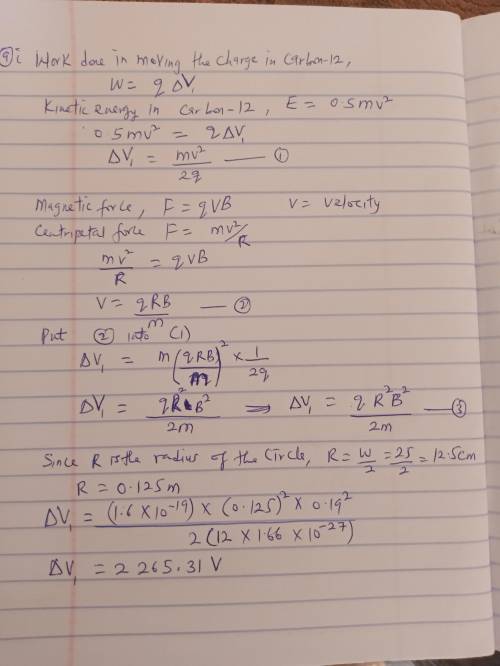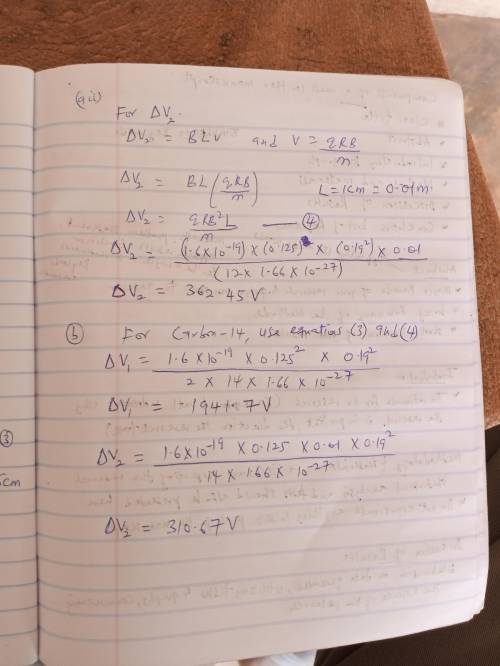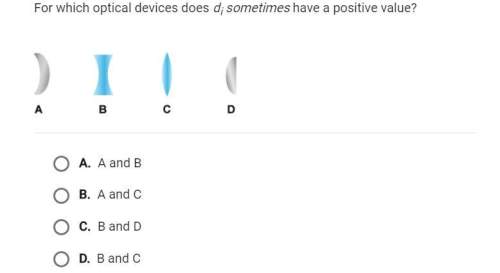
Physics, 05.05.2020 03:43 kaylaaguilar6538
Mass spectrometer A mass spectrometer is a tool used to determine accurately the mass of individual ionized atoms or molecules, or to separate atoms or molecules that have similar but slightly different masses. For example, you can deduce the age of a small sample of cloth from an ancient tomb, by using a mass spectrometer to determine the relative abundances of carbon-14 (whose nucleus contains 6 protons and 8 neutrons) and carbon-12 (the most common isotope, whose nucleus contains 6 protons and 6 neutrons). In organic material, the ratio of 14C to 12C depends on how old the material is, which is the basis for "carbon-14 dating." 14C is continually produced in the upper atmosphere by nuclear reactions caused by "cosmic rays" (high-energy charged particles from outer space, mainly protons), and 14C is radioactive with a half-life of 5700 years. When a cotton plant is growing, some of the CO2 it extracts from the air to build tissue contains 14C which has diffused down from the upper atmosphere. But after the cotton has been harvested there is no further intake of 14C from the air, and the cosmic rays that create 14C in the upper atmosphere can't penetrate the atmosphere and reach the cloth. So the amount of 14C in cotton cloth continually decreases with time, while the amount of non-radioactive 12C remains constant.
Carbon from the sample is ionized in the ion source at the left. The resulting singly ionized 12C+ and 14C+ ions have negligibly small initial velocities (and can be considered to be at rest). They are accelerated through the potential difference ΔV1. They then enter a region where the magnetic field has a fixed magnitude B = 0.19 T. The ions pass through electric deflection plates that are 1 cm apart and have a potential difference ΔV2 that is adjusted so that the electric deflection and the magnetic deflection cancel each other for a particular isotope: one isotope goes straight through, and the other isotope is deflected and misses the entrance to the next section of the spectrometer. The distance from the entrance to the fixed ion detector is a distance of w = 25 cm. There are controls that let you vary the accelerating potential ΔV1 and the deflection potential ΔV2 in order that only 12C+ or 14C+ ions go all the way through the system and reach the detector. You count each kind of ion for fixed times and thus determine the relative abundances. The various deflections ensure that you count only the desired type of ion for a particular setting of the two voltages.
Determine the appropriate numerical values of ΔV1 and ΔV2 for 12C. Carry out your intermediate calculations algebraically, so that you can use the algebraic results in the next part.
ΔV1 = 4 V
ΔV2 = 5 V
Determine the appropriate numerical values of ΔV1 and ΔV2 for 14C.
ΔV1 = 6 V
ΔV2 = 7 V

Answers: 2


Another question on Physics

Physics, 22.06.2019 10:50
Two rigid transformations are used to map δhjk to δlmn. the first is a translation of vertex h to vertex l. what is the second transformation? a reflection across the line containing hk a rotation about point h a reflection across the line containing hj a rotation about point k
Answers: 1

Physics, 22.06.2019 12:30
Aboy with a mass 25 kg climbs into a small tree. he sits on a branch that is 2.o m above to the ground.what is his gravitational potential energy above the ground?
Answers: 1


Physics, 23.06.2019 01:10
Calculate 9 ∙ 10-5 divided by 3 ∙ 10-9. (box after the "10" in answer is for the
Answers: 1
You know the right answer?
Mass spectrometer A mass spectrometer is a tool used to determine accurately the mass of individual...
Questions

Mathematics, 04.02.2021 17:20


English, 04.02.2021 17:20


Mathematics, 04.02.2021 17:20

History, 04.02.2021 17:20



English, 04.02.2021 17:20

Mathematics, 04.02.2021 17:20



Business, 04.02.2021 17:20

Mathematics, 04.02.2021 17:20



Biology, 04.02.2021 17:20


German, 04.02.2021 17:20

Social Studies, 04.02.2021 17:20






